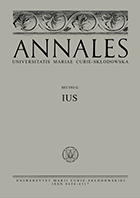Wznowienie i organizacja sądownictwa polskiego w Zamościu w latach 1918–1919
Reactivation and Organisation of the Polish Judicial System in Zamość in 1918–1919
Author(s): Arkadiusz BerezaSubject(s): Law, Constitution, Jurisprudence, Recent History (1900 till today), Pre-WW I & WW I (1900 -1919)
Published by: Wydawnictwo Naukowe Uniwersytetu Marii Curie-Sklodowskiej
Keywords: judiciary; courts of the Kingdom of Poland; magistrates’ courts; Zamość; judges; prosecutors; investigative judges; Zamoyski Palace;
Summary/Abstract: During World War I, after the evacuation of the Russian authorities, a local grassroots judiciary system was established in July 1915 in Zamość and surroundings on the initiative of local lawyers. It operated for a short period and then was disbanded by the Austrian occupation authorities. However, the courts of the lowest instance remained, bound within the instance system with the occupation administration and military courts. In Zamość, the Magistrate’s Court and the Military Regional (District) Court were functioning. Following the proclamation of the Act of 5 November of 1916 by the German and Austro-Hungarian Emperors, according to the provisions contained therein, the work aimed at handing over the judiciary in the occupied territories of the Kingdom of Poland to Polish hands was commenced. On 1 September 1917, the courts of the Kingdom of Poland were opened, including the Magistrate’s Court in Zamość. As a result of the initiative of the municipal authorities of Zamość and local social organizations, the Regency Council of the Kingdom of Poland decided to establish the District Court of the Kingdom of Poland in Zamość. It was inaugurated on 1 June 1918 with Romuald Jaśkiewicz as its President, who had previously been the justice of peace of Zamość. The court was composed of four district judges, four investigating judges and one district prosecutor and three deputy prosecutors. These positions were assumed by attorneys in law, lawyers coming from Galicia, as well as Polish lawyers who had returned from Russia torn by the civil war. Lower positions such as investigative judges were also assumed by trainee judges. In the years 1918–1919, significant rotation of personnel in these positions could be observed. The Zamość District covered four counties (in Polish: powiaty): Zamość, Biłgoraj, Hrubieszów and Tomaszów, with 19 peace courts operating in their respective areas. They comprised two magistrates’ courts in Zamość, covering the so-called municipal district and rural district. These were presided by Zygmunt Kostkiewicz and Adam Sajkiewicz. In November 1918, the courts of Zamość began to issue judgements “on behalf of the Republic of Poland”, and soon afterwards these courts were seated in the Zamoyski Palace refurbished for that purpose.
Journal: Annales Universitatis Mariae Curie-Skłodowska, sectio G – Ius
- Issue Year: 66/2019
- Issue No: 1
- Page Range: 35-51
- Page Count: 17
- Language: Polish

